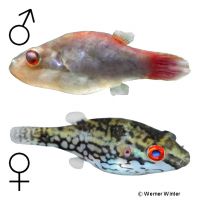Red Tailed Red Eye Puffer (Carinotetraodon irrubesco)
| Red Tailed Red Eye Puffer Carinotetraodon irrubesco | |
|---|---|
| Name | Red Tailed Red Eye Puffer |
| Name Lat. | Carinotetraodon irrubesco |
| Family | Puffers |
| Family lat. | Tetraodontidae |
| Order | Puffers & Filefishes |
| Order lat. | Tetraodontiformes |
| Origin | Sumatra, Borneo |
| Habitat | Streams, rivers |
| Diet | Carnivore |
| pH | 6.0-7.5 |
| Behavior | Semi-aggressive |
| Keeping | Pair, group |
| Care Level | Moderate |
| Reproduction | Substrate spawner |
| Breeding | Difficult |
| Life Span | 5-8 years |
| Protection | No |
| Metric Units | |
| Size | 4.5 cm |
| Temperature | 20-28 °C |
| Hardness | 2-12 °dH |
| Aquarium | ~ 60 l |
| US Units | |
| Size | 1.8" |
| Temperature | 68-82 °F |
| Hardness | 36-214 ppm |
| Aquarium | ~ 15 gal |
Distribution and habitat
The red-tailed crested puffers are found in the lower inlet of the Banjuasin River (South Sumatra) and in the Sambas River in Kalimantan Barat (Borneo). There they live in streams and small rivers where they stay in the densely vegetated shore regions with weak currents.
Maintenance
The aquarium should have a dense border and background planting, with many hiding places (stones, roots) and provide sufficient swimming space. A dark, fine sandy substrate covered with some foliage (e.g. sea almond leaves), some shaded light (floating plants) and soft, slightly acidic water with a weak current is ideal.
No ammonia, ammonium and nitrite should be detectable, the nitrate value should not exceed 100 mg/l. To ensure the water quality and oxygen content, a filter and heater adapted to the aquarium size is required, as well as lighting for the species-appropriate day-night rhythm of the animals.
Diet
They are food specialists, eating almost exclusively water snails and crustaceans. The food supply therefore consists mainly of snails (e.g. bubble snails or apple snails) supplemented with live or frozen food, such as shrimps, mosquito larvae, artemia, mysis, etc., as well as mussel and crab meat or a frozen special food mixture. Flake or granulated food is rarely accepted. It is recommended to feed small portions several times a day, which are eaten within a few minutes. A regular and varied diet promotes health and increases resistance.
Behaviour and compatibility
It is recommended to keep these relatively peaceful pufferfish in pairs or in a group where the number of females predominates. A larger, richly structured tank is recommended for group keeping. They are considered fin twitchers and should only be socialized with short-finned, fast swimming fish
Basically, only compatible fish species with similar requirements for water condition and water temperature should be socialized.
Sex dimorphism
The males have a broad red ventral stripe and occasionally a reddish back. The female is smaller and rounder.
Reproduction and breeding
Red-tailed crested puffers are substrate spawners. When a harmonizing pair is found, the female spawns up to 300 eggs on a plant (java moss). The male intensively defends the clutch. After about 65 hours the larvae hatch and swim free after 3 days.
Fry must be fed several times a day with special rearing food (e.g. Brachionus). In community tanks breeding is hardly possible, because the spawn is easy prey.
Important
They need the hard shells of snails to wear down their teeth, which are constantly growing back. Too long teeth make it impossible for them to eat and they would starve.
Pufferfish can inflate to twice their size by filling their expandable stomach with air or water
A cup filled with aquarium water, not a catch net, should be used for transferring or inserting them to prevent them from becoming airborne.
The well-being of the fish should be checked regularly. Temperature should be checked daily, pH, hardness and nitrate levels at least every 14 days. Regular partial water changes are recommended, even if the contaminant level has not yet reached the upper limit. Sudden changes in water quality should be avoided. Newly introduced fish must be accustomed slowly to the water in the aquarium.
Further literature can be found in your pet store.
References
Text: petdata; Image: Werner Winter
Source: BMEL (1998): Tierschutzgutachten - Haltung von Zierfischen (Süßwasser); ENGELMANN (2005): Zootierhaltung - Tiere in menschlicher Obhut: Fische, Verlag Harri Deutsch
- Gemäß § 21 Abs. 5 Tierschutzgesetz idgF
